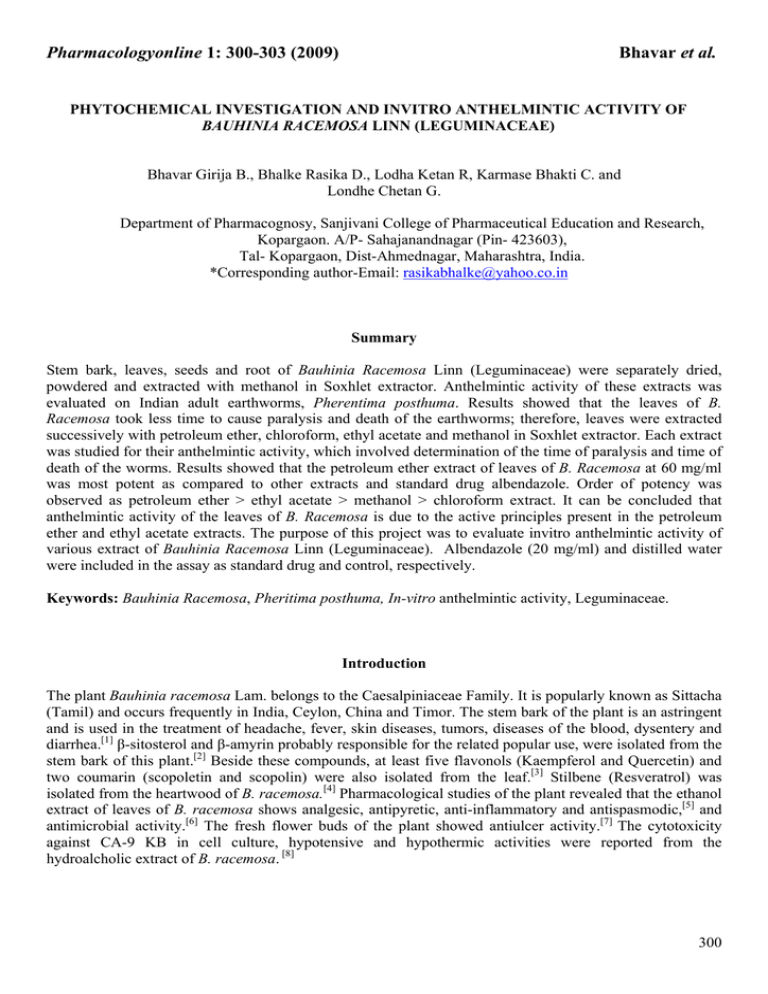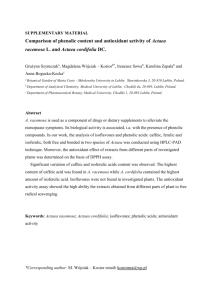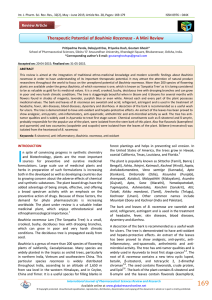Pharmacologyonline
advertisement

Pharmacologyonline 1: 300-303 (2009) Bhavar et al. PHYTOCHEMICAL INVESTIGATION AND INVITRO ANTHELMINTIC ACTIVITY OF BAUHINIA RACEMOSA LINN (LEGUMINACEAE) Bhavar Girija B., Bhalke Rasika D., Lodha Ketan R, Karmase Bhakti C. and Londhe Chetan G. Department of Pharmacognosy, Sanjivani College of Pharmaceutical Education and Research, Kopargaon. A/P- Sahajanandnagar (Pin- 423603), Tal- Kopargaon, Dist-Ahmednagar, Maharashtra, India. *Corresponding author-Email: rasikabhalke@yahoo.co.in Summary Stem bark, leaves, seeds and root of Bauhinia Racemosa Linn (Leguminaceae) were separately dried, powdered and extracted with methanol in Soxhlet extractor. Anthelmintic activity of these extracts was evaluated on Indian adult earthworms, Pherentima posthuma. Results showed that the leaves of B. Racemosa took less time to cause paralysis and death of the earthworms; therefore, leaves were extracted successively with petroleum ether, chloroform, ethyl acetate and methanol in Soxhlet extractor. Each extract was studied for their anthelmintic activity, which involved determination of the time of paralysis and time of death of the worms. Results showed that the petroleum ether extract of leaves of B. Racemosa at 60 mg/ml was most potent as compared to other extracts and standard drug albendazole. Order of potency was observed as petroleum ether > ethyl acetate > methanol > chloroform extract. It can be concluded that anthelmintic activity of the leaves of B. Racemosa is due to the active principles present in the petroleum ether and ethyl acetate extracts. The purpose of this project was to evaluate invitro anthelmintic activity of various extract of Bauhinia Racemosa Linn (Leguminaceae). Albendazole (20 mg/ml) and distilled water were included in the assay as standard drug and control, respectively. Keywords: Bauhinia Racemosa, Pheritima posthuma, In-vitro anthelmintic activity, Leguminaceae. Introduction The plant Bauhinia racemosa Lam. belongs to the Caesalpiniaceae Family. It is popularly known as Sittacha (Tamil) and occurs frequently in India, Ceylon, China and Timor. The stem bark of the plant is an astringent and is used in the treatment of headache, fever, skin diseases, tumors, diseases of the blood, dysentery and diarrhea.[1] β-sitosterol and β-amyrin probably responsible for the related popular use, were isolated from the stem bark of this plant.[2] Beside these compounds, at least five flavonols (Kaempferol and Quercetin) and two coumarin (scopoletin and scopolin) were also isolated from the leaf.[3] Stilbene (Resveratrol) was isolated from the heartwood of B. racemosa.[4] Pharmacological studies of the plant revealed that the ethanol extract of leaves of B. racemosa shows analgesic, antipyretic, anti-inflammatory and antispasmodic,[5] and antimicrobial activity.[6] The fresh flower buds of the plant showed antiulcer activity.[7] The cytotoxicity against CA-9 KB in cell culture, hypotensive and hypothermic activities were reported from the hydroalcholic extract of B. racemosa. [8] 300 Pharmacologyonline 1: 300-303 (2009) Bhavar et al. Material and Methods Plant material Stem bark, leaves, seeds and root of Bauhinia Racemosa Linn (Leguminaceae) were collected from Ahmednagar district, Maharashtra (India) in August 2007. The plant specimen was authenticated from Botanical Survey of India, Pune (Voucher specimen no. BRLCG1). Animals Indian adult earthworms (Pheretima posthuma) collected from moist soil and washed with normal saline to remove all faecal matter were used for the anthelmintic study. The earthworms of 3-5cm in length and 0.10.2 cm in width were used for all the experimental protocol due to their anatomical and physiological resemblance with the intestinal roundworm parasites of human beings.[9, 10] Drugs and chemicals Albendazole (Pfizer Ltd., Bangalore), Petroleum ether (PCL, Pune), Chloroform (PCL, Pune), ethyl acetate (PCL, Pune), Methanol A. R. (PCL, Pune), DMF (PCL, Pune), Saline water (Nurilife, Ahmedabad). Preparation of extracts Dried and coarsely powdered stem bark, leaves, seeds and roots of B. Racemosa (500 g, each) was separately subjected to extraction in Soxhlet extractor using methanol as a solvent. The extracts of stem bark, leaves, seeds and roots of B. Racemosa were concentrated by vacuum distillation and then dried in open air to yield 6.2%, 6.3%, 5.2%, 6.0% of extracts, respectively. The most active part i.e. leaves (1000 g) (based on primary anthelmintic screening) were dried, coarsely powdered and subjected to successive solvent extraction in Soxhlet extractor by using petroleum ether (60-80oC), chloroform, ethyl acetate and methanol as a solvent. The respective extracts were concentrated by vacuum distillation and then dried in open air to give 6.7%, 4.5%, 7.9% and 6.0% of extracts, respectively. [11] Anthelmintic Activity [12, 13] All the extracts of stem bark, leaves, seeds and roots of B. Racemosa were dissolved in minimum amount of DMF and then volume is adjusted to 10 ml with saline water. All extracts and albendazole solutions were freshly prepared before starting the experiment. Six groups, of six earthworms each were released into 10 ml of desired formulations as follows; vehicles (5% DMF in normal saline), Albendazole (20 mg/ml), or total methanolic extracts of stem bark, leaves, seeds and roots of B. Racemosa (20 mg/ ml, each) in normal saline containing 5% DMF. In the second set of experiment, fourteen groups of six earthworms were released in to 10 ml of desired formulations as follows; vehicle (5% DMF in normal saline), albendazole (20 mg/ml), or petroleum ether extract or chloroform extract or ethyl acetate extract or methanolic extract of leaves of B. Racemosa (20 mg/ml, 40 mg/ml, 60 mg/ml each) in normal saline containing 5% DMF. Observations were made for the time taken to paralysis and death of individual worms. Time for paralysis was noted when no movement of any sort could be observed except when the worms were shaken vigorously. Time for death of worms were recorded after ascertaining that the worms neither moved when shaken vigorously nor when dipped in warm water (50 °C). Death was concluded when the worms lost their motility followed with fading away of their body colors. All the results were expressed as a mean ± SEM of six animals in each group. Results and Discussion The data revealed that total methanolic extracts of various parts of the plant B. Racemosa showed significant anthelmintic activity at 20 mg/ml concentrations, amongst all, total methanolic extract of leaves of B. Racemosa showed best anthelmintic activity as shown in Table 1. Results are comparable with standard drugs Albendazole, at same concentration. In order to find out active constituents from leaves, which are responsible for the activity whether polar or nonpolar compounds, successive extraction of leaves of B. Racemosa was done by using solvents like petroleum ether, chloroform, ethyl acetate and methanol. All extracts were screened for anthelmintic activity. The results show that petroleum ether extract (at 60 mg/ml) of leaves of B. Racemosa took the least time to cause paralysis (2.11min) and death (2.02 min) of the earthworms, followed by ethyl acetate, methanolic extracts and chloroform extract respectively. The standard drug, Albendazole shows paralysis at 2.06 min and death after 1.05 min (at 60 mg/ml). 301 Pharmacologyonline 1: 300-303 (2009) Bhavar et al. Table 1. Anthelmintic activity of methanolic extracts of stem bark, leaves, seeds and root of Bauhinia Racemosa Linn. Treatment Dose mg/ml BME LME SME RME ALBENDAZOLE Time of paralysis (min) ± SEM 8.48 ± 0.00577 3.45 ± 0.0023 9.65 ± 0.01202 8.33 ± 0.00881 3.08 ± 0.00577 Time of Death (min) ± SEM 10.53 ± 0.0115 3.03 ± 0.065 8.19 ± 0.0318 7.52 ± 0.087 2.23 ± 0.1453 20 20 20 20 20 5% DMF in CONTROL normal saline BME- total methanol extract of bark, LME- total methanol extract of leaves, SMEtotal methanol extract of seeds, RME- total methanol extract of roots. All the results were expressed as a mean ± SEM of six animals in each group. Table 2. Anthelmintic activity of various extracts of leaves of Bauhinia Racemosa Linn. Treatment PEL Dose mg/ml Time of paralysis (min) Time of Death (min) ± ± SEM SEM 3.57 ± 0.0094 2.53 ± 0.45 3.45 ± 0.00881 2.45 ± 0.091 2.11 ± 0.056 2.02± 0.095 9.48 ± 0.0057 5.03 ± 0.015 8.34 ± 0.012 4.61 ± 0.011 7.29 ± 0.0133 3.2 ± 0.0077 4.65 ± 0.012 3.196 ± 0.038 3.58 ± 0.0078 2.363 ± 0.033 3.48 ± 0.0081 1.38 ± 0.033 8.33 ± 0.0081 4.52 ± 0.0081 7.24 ± 0.088 3.19 ± 0.034 7.25 ± 0.0020 3.01 ± 0.0037 3.08 ± 0.0057 2.23 ± 0.14 2.07 ± 0.0015 1.24 ± 0.0088 2.06 ± 0.0059 1.05 ± 0.0057 20 40 60 CHL 20 40 60 EAL 20 40 60 MEL 20 40 60 20 ALBENDAZOLE 40 60 CONTROL 5% DMF in normal saline PEL- petroleum ether extract of leaves, CHL- chloroform extract of leaves, EAL- ethyl acetate extract of leaves, MEL- methanol extract of leaves. All the results were expressed as a mean ± SEM of six animals in each group. Results of preliminary phytochemical tests suggest that petroleum ether extract of leaves contain sterols, carbohydrates, triterpenes and fatty substances; chloroform extract contain sterols; ethyl acetate extract of leaves contain flavanoids, glycosides and methanolic extract of seeds contain tannins, glycosides and alkaloids. It can be concluded that active constituents responsible for anthelmintic activity are present in the petroleum ether and ethyl acetate extracts of leaves of B. Racemosa. This indicates that the anthelmintic 302 Pharmacologyonline 1: 300-303 (2009) Bhavar et al. principles are nonpolar compounds. The function of the anthelmintic drugs like Albendazole is to cause paralysis of worms so that they are expelled in the feaces of human being and animals. The extracts not only demonstrated this property, they also caused death of the worms. And further study was carried out for isolation of the chemical constituent responsible for anthelmintic activity. Further studies using in vivo models are required to carry out and establish the effectiveness and pharmacological rationale for the use of leaves of B. Racemosa as an anthelmintic drug. The drug may be further explored for its phytochemical profile to identify the active constituent responsible for anthelmintic activity. References 1. Kirtikar KR, Basu BD. In. Indian Medicinal Plants, vol 2, Dehradun, India. Bishen Mahendra Pal Singh; 1975. p. 842-844. 2. Prakash A, Khosa RL. Chemical studies on Bauhini racemosa. Curr Sci: 1976; 45: 705. 3. El-Hossary GA, Selim MA, Sayed AE, Khaleel AE. Study of the flavonoid content of Bassia muricata and Bauhinia racemosa. Bull Fac Pharm Cairo Univ:2000; 38: 93-97. 4. Anjaneyulu ASR, Reddy AVR, Reddy DSK, Ward RS, Adhikesavalu D, Cameron TS. A new dibenzo (2,3-6,7) oxepin derivative from Bauhinia racemosa. Tetrahedron:1984; 40: 4245-4252. 5. El-Khatiba AS, Khaleel AE. Evaluation of some pharmacologi-cal properties of different extract of Bauhinia racemosa leaf and Bassia muricata whole plant. Bull Fac Pharm Cairo Univ: 1995; 33: 59-65. 6. Ali MS, Azhar I, Amtul Z, Ahmad VU, Usmanghani K. Antim-icrobial screening of some Caesalpiniaceae. Fitoterapia:1999; 70: 299-304. 7. Akhtar AH, Ahmad KU. Anti-ulcerogenic evaluation of the methanol extract of some indigenous medicinal plants of Pakistan in aspirin ulcerated rats. J Ethnopharmacol: 1995; 46: 1-6. 8. Dhar ML, Dhar MM, Dhawan BN, Mehrotra BN, Roy C. Screening of Indian plants for biological activity. Ind J Expt Biol: 1968; 6: 232-247. 9. Thorn GW, Adams RD, Braunwald E, Isselbacher KJ and Petersdrof RG. Harrison's Principles of Internal Medicine. In: Mcgraw Hill Co., New York, 1977. p. 1088-1089. 10. Vigar, Z. Atlas of Medical Parasitology. In: 2nd ed. P.G. Publishing House, Singapore, 1984. p. 216-217. 11. Harborne JB. Phytochemical methods. In: A guide to Modern Techniques of Analysis, Chapman and Hall Publishers, London; 1973. p. 4-7. 12. Tambe VD, Girme AS, Nirmal SA, Bhambar RS, Ghogare PB, Bhalke RD, et al. Anthelmintic activity of Wedelia trilobata, Ind. J. Nat. Prod: 2006; 22 (3): 27. 13. Dash GK, Mishra B, Panda P, and Ganapaty S. Anthelmintic activity of Evolvulus nummularius. Ind. J. Nat. Prod: 2003; 19: 24-26. 303




